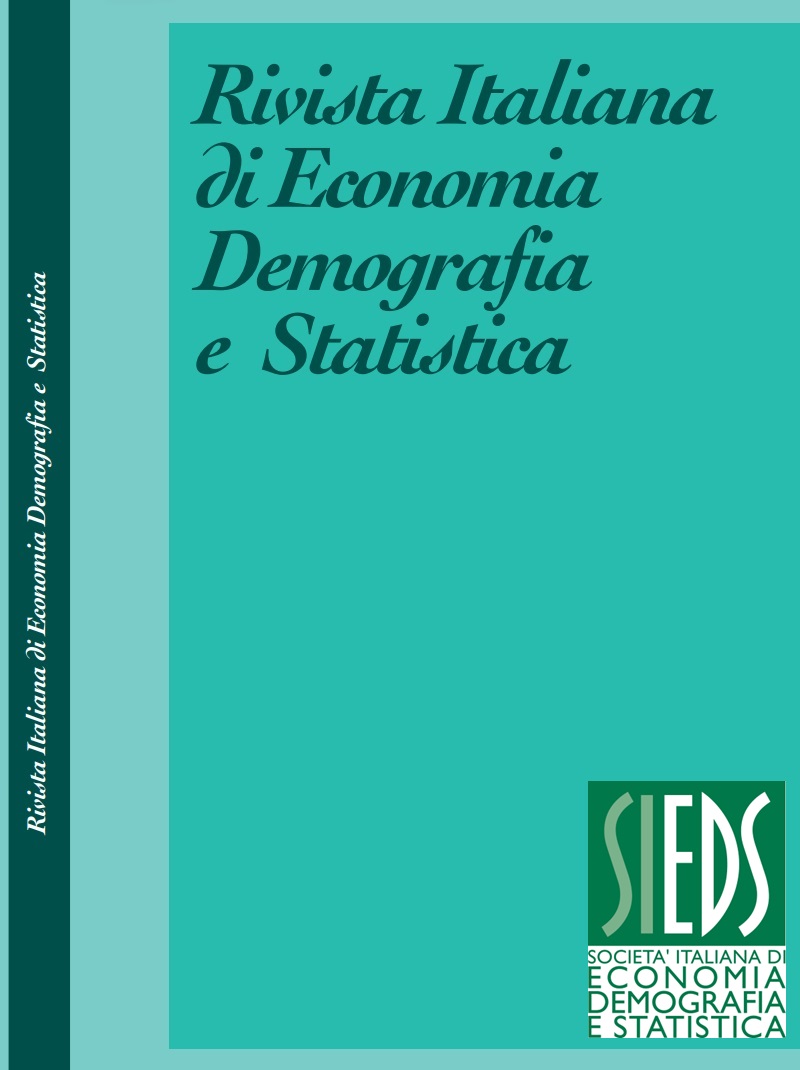Collecting data on migrants’ health status and access to health services: the experience of the mobile app “ComeStai”
DOI:
https://doi.org/10.71014/sieds.v79i3.286Keywords:
Health, Immigration, Mobile apps, Survey data, LombardyAbstract
Despite the process of migrant settlement in Italy, there is still a lack of data on migrant health and access to health services. We have developed the mobile app “ComeStai” to collect new data on this population.
ComeStai collects new and original information on migrants' self-assessed health status and access to health care through short surveys. The main questionnaire includes questions about the respondent's immigrant status, health status and health habits, access to and use of health care, and socio-demographic characteristics. Every month, the app displays a follow-up survey to track key variables over time, including respondents' health status and experiences of barriers to accessing health care.
After submitting the answers to the main questionnaire, the user can access an in-app platform that provides an overview of the Italian public health system and regulations, a brief description of the main public health services, and a list of NGOs providing health services or support in the Metropolitan area of Milan, as well as their location on a map.
Our study aims to test the efficacy of a mobile application as a data collection tool. We present the fieldwork and discuss the advantages and challenges of such a tool. Our evaluation considers the sample size achieved, the heterogeneity and representativeness of the sample to the real population. Based on the results, we will evaluate whether to extend the research to a larger geographical scale.
References
COUPER M.P. 2013. Is the Sky Falling? New Technology, Changing Media, and the Future of Surveys, Survey Research Methods Vol. 7, No. 3, pp. 145-156.
FAN W., YAN Z. 2010. Factor affecting response rate of the web survey: A systematic review, Computers in Human Behavior, Vol. 26, pp. 132-139. DOI: https://doi.org/10.1016/j.chb.2009.10.015
HADDAD C., SACRE H., ZEENY R.M., HAJI A., AKEL M., ISKANDAR K., SALAMEH P. 2022. Should sample be weighted to decrease selection bias in online surveys during the COVID-19 pandemic? Data from seven datasets, BMC Medical Research Methodology, Vol. 22 No. 63. DOI: https://doi.org/10.1186/s12874-022-01547-3
JÄCKLE A., BURTON J., COUPER M. P. 2023. Understanding Society: minimising selection biases in data collection using mobile apps, Fiscal Studies, Vol. 44, pp. 361–376. DOI: 10.1111/1475-5890.12351. DOI: https://doi.org/10.1111/1475-5890.12351
JÄCKLE A., WENZ A., BURTON J., COUPER M.P. 2022. Increasing Participation In A Mobile App Study: The Effects Of A Sequential Mixed mode Design And In-Interview Invitation, Journal of Survey Statistics and Methodology, Vol. 10, pp. 898–922. DOI: https://doi.org/10.1093/jssam/smac006
JACOBSEN J., KÜHNE S. 2021. Using Mobile App When Surveying Highly Mobile Populations: Panel Attrition, Consent, and Interviewer Effect in a Survey of Refugees, Social Science Computer Review, Vol. 39, No. 4, pp. 721-743. DOI: https://doi.org/10.1177/0894439320985250
LOR M., BOWERS B. J., KRUPP A., JACOBSON N. 2017. Tailored explanation: A strategy to minimize nonresponse in demographic items among low-income racial and ethnic minorities, Survey Practice, Vol. 10, No. 3, pp. 1-11. DOI: https://doi.org/10.29115/SP-2017-0015
MARCANO BELISARIO J.S., JAMSEK J., HUCKVALE K., O’DONOGHUE J., MORRISON C.P., CAR J. 2015. Comparison of self-administered survey questionnaire responses collected using mobile apps versus other methods (Review), Cochrane Database of Systematic Reviews, Vol. 7, No. MR000042. DOI: https://doi.org/10.1002/14651858.MR000042.pub2
MERCER A., LAU A., KENNEDY C. 2018. For Weighting Online Opt-In Samples, What Matter Most? Pew Research Center https://www.pewresearch.org/methods/2018/01/26/for-weighting-online-opt-in-samples-what-matters-most/
OAKLEY-GIRVAN I., LAVISTA J. M., MILLER Y., DAVIS S., ACLE C., HANCOCK J., NELSON L. M., 2018. Evaluation of a Mobile Device Survey System for Behavioral Risk Factors (SHAPE): App Development and Usability Study, JMIR Formativ Res, vol. 3, No. 1 e10246. DOI: https://doi.org/10.2196/10246
ROCHEVA A., VARSHAVER E., IVANOVA N. 2022.Targeting on Social Networking Sites as Sampling Strategy for Online Migrant Surveys: The Challenge of Biases and Search for Possible in S. PÖTZSCHKE, S. RINKEN (Eds.), Migration Research in a Digitized World, IMISCOE Research Series, https://doi.org/10.1007/978-3-031-01319-5_3, pp. 35- 58 DOI: https://doi.org/10.1007/978-3-031-01319-5_3
WENZ A., KEUSCH F. (2023) Increasing the Acceptance of Smartphone-Based Data Collection, Public Opinion Quarterly, Vol. 87, No. 2, pp. 357–388. DOI: https://doi.org/10.1093/poq/nfad019
ZHANG J., CALABRESE C., DING J., LIU M., ZHANG B. 2018. Advantages and challenges in using mobile apps for field experiments: A systematic review and a case study, Mobile Media & Communication, Vol. 6, No. 2, pp. 179–196. DOI: https://doi.org/10.1177/2050157917725550
Downloads
Published
Issue
Section
License
Copyright (c) 2025 Chiara Allegri, Alessandro Avellone, Elisa Barbiano di Belgojoso, Sara Khatab, Dario Pescini, Stefania Rimoldi, Antonella Zambon

This work is licensed under a Creative Commons Attribution 4.0 International License.



